Unit 8 Literature_高二英语北师大版(2019)选择性必修第三册教材习题精讲课件(共51张)
文档属性
| 名称 | Unit 8 Literature_高二英语北师大版(2019)选择性必修第三册教材习题精讲课件(共51张) |
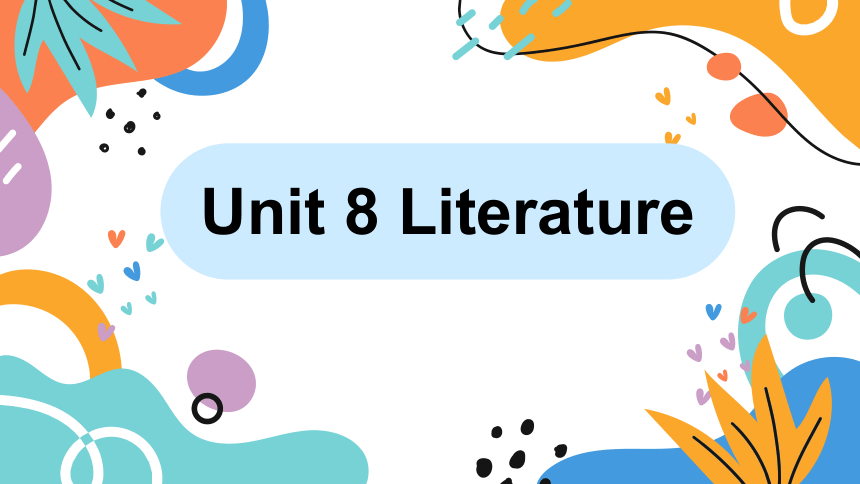
|
|
| 格式 | pptx | ||
| 文件大小 | 3.7MB | ||
| 资源类型 | 教案 | ||
| 版本资源 | 北师大版(2019) | ||
| 科目 | 英语 | ||
| 更新时间 | 2025-04-02 21:51:00 | ||
图片预览

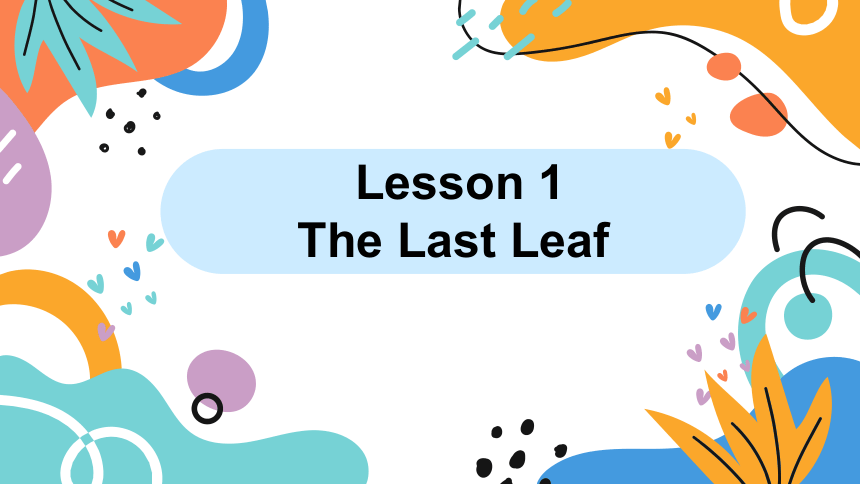
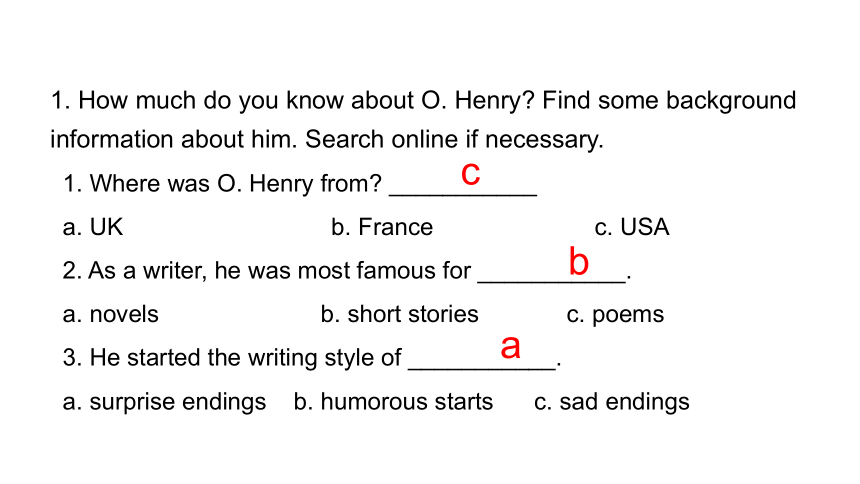
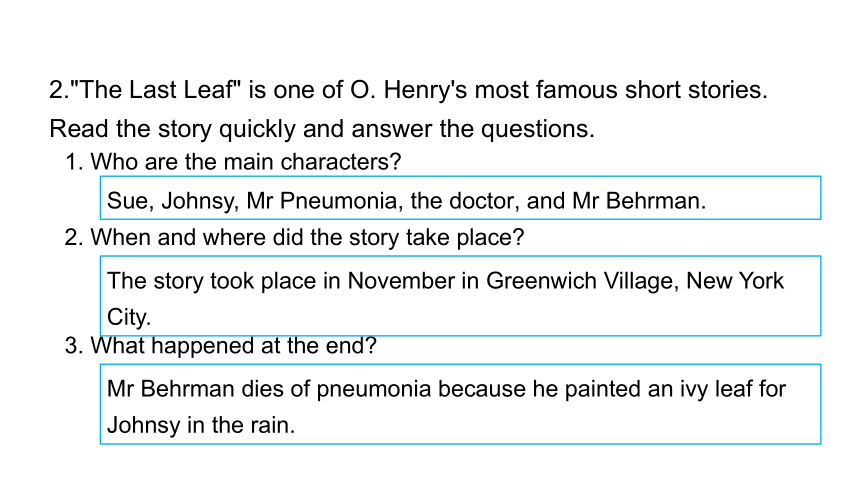
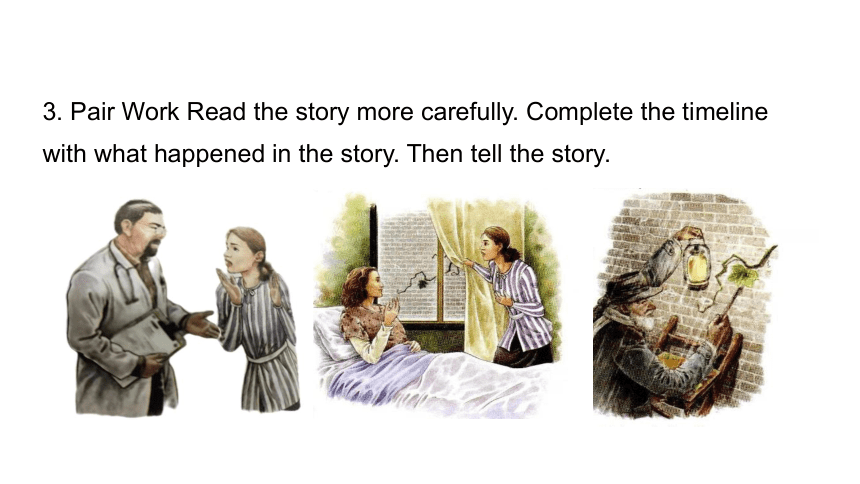
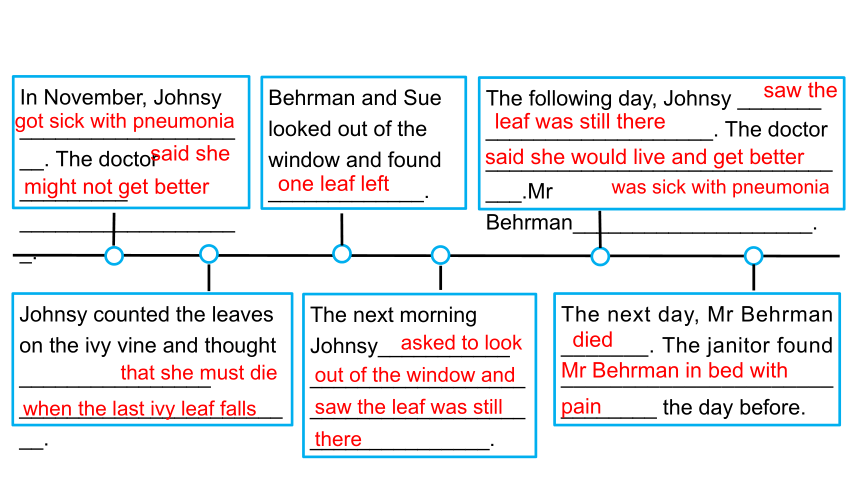
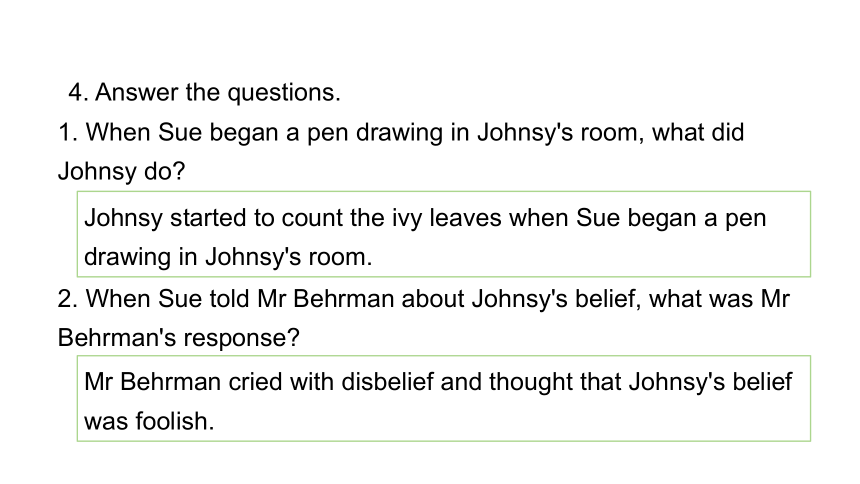

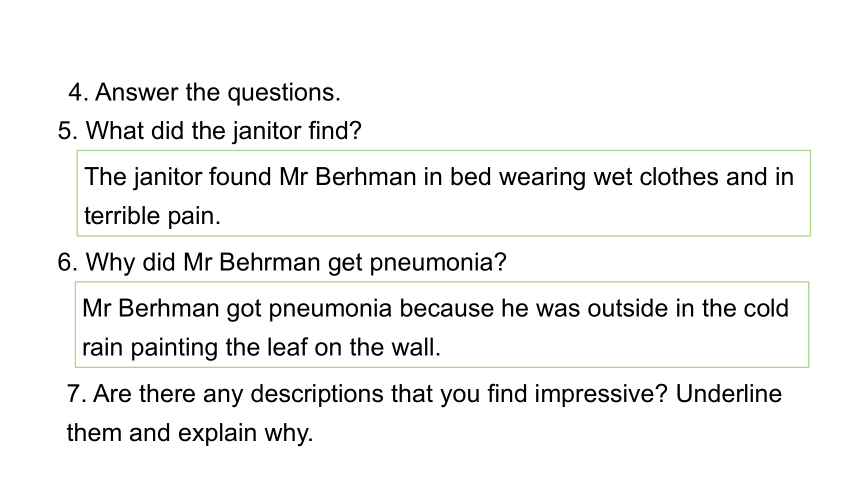
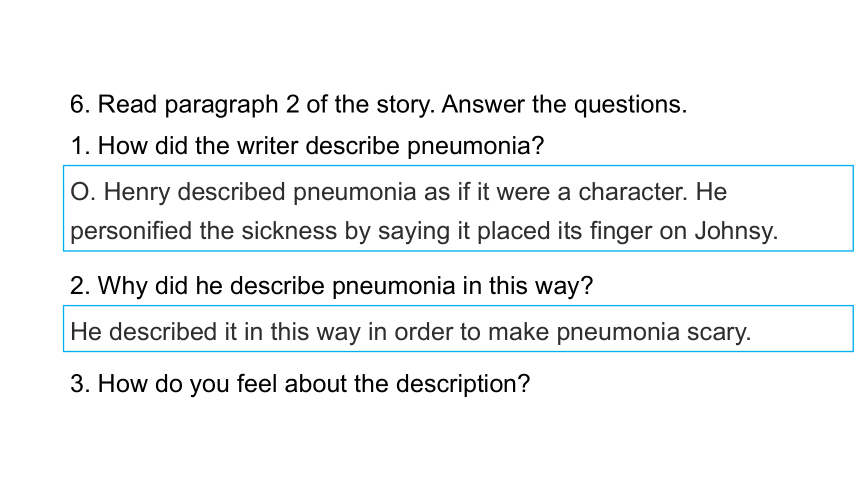
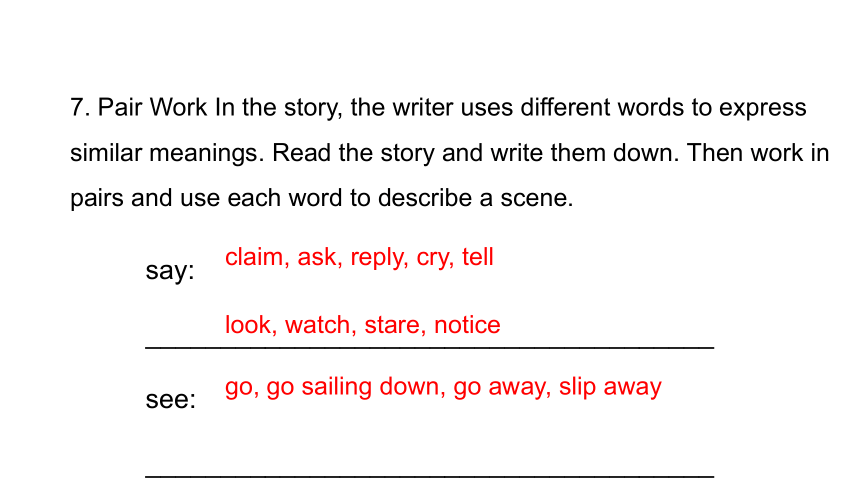
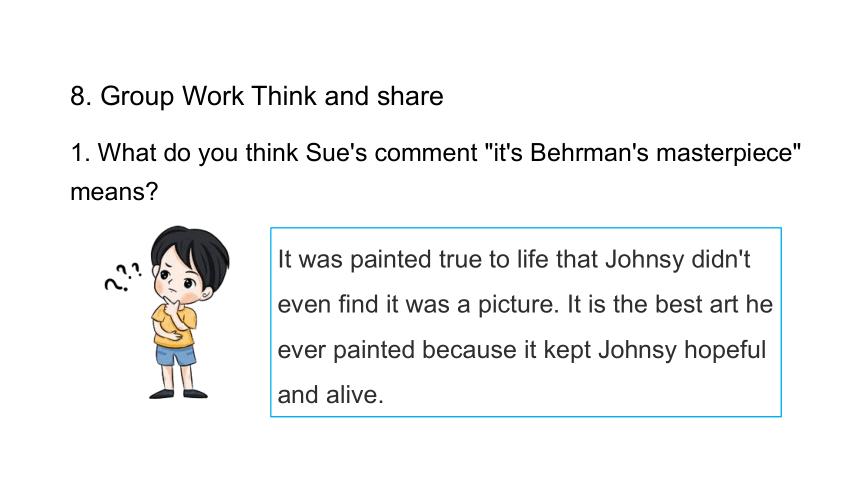
文档简介
(共51张PPT)
Unit 8 Literature
Lesson 1
The Last Leaf
1. How much do you know about O. Henry Find some background information about him. Search online if necessary.
1. Where was O. Henry from ___________
a. UK b. France c. USA
2. As a writer, he was most famous for ___________.
a. novels b. short stories c. poems
3. He started the writing style of ___________.
a. surprise endings b. humorous starts c. sad endings
c
b
a
2."The Last Leaf" is one of O. Henry's most famous short stories.
Read the story quickly and answer the questions.
1. Who are the main characters
Sue, Johnsy, Mr Pneumonia, the doctor, and Mr Behrman.
3. What happened at the end
2. When and where did the story take place
The story took place in November in Greenwich Village, New York City.
Mr Behrman dies of pneumonia because he painted an ivy leaf for Johnsy in the rain.
3. Pair Work Read the story more carefully. Complete the timeline with what happened in the story. Then tell the story.
In November, Johnsy ____________________. The doctor _________
___________________.
Johnsy counted the leaves on the ivy vine and thought ________________
________________________.
Behrman and Sue looked out of the window and found _____________.
The next morning Johnsy___________
___________________________________________________.
The next day, Mr Behrman _______. The janitor found ______________________________ the day before.
The following day, Johnsy _______
___________________. The doctor ________________________________.Mr Behrman____________________.
said she
might not get better
one leaf left
that she must die when the last ivy leaf falls
asked to look out of the window and saw the leaf was still there
saw the
said she would live and get better
was sick with pneumonia
died
Mr Behrman in bed with pain
got sick with pneumonia
leaf was still there
4. Answer the questions.
1. When Sue began a pen drawing in Johnsy's room, what did Johnsy do
Johnsy started to count the ivy leaves when Sue began a pen drawing in Johnsy's room.
2. When Sue told Mr Behrman about Johnsy's belief, what was Mr Behrman's response
Mr Behrman cried with disbelief and thought that Johnsy's belief was foolish.
3. Behrman said, "This is not a place in which Miss Johnsy shall lie sick. Someday I will paint a masterpiece, and we shall all go away." What did he mean
Mr Behrman realised that Johnsy would become better, and that he would paint his masterpiece before they all died.
4. How did Johnsy change her attitude
She saw that the last leaf remained brave and realised that she was wrong to want to die.
4. Answer the questions.
5. What did the janitor find
The janitor found Mr Berhman in bed wearing wet clothes and in terrible pain.
6. Why did Mr Behrman get pneumonia
Mr Berhman got pneumonia because he was outside in the cold rain painting the leaf on the wall.
7. Are there any descriptions that you find impressive Underline them and explain why.
4. Answer the questions.
6. Read paragraph 2 of the story. Answer the questions.
1. How did the writer describe pneumonia
O. Henry described pneumonia as if it were a character. He personified the sickness by saying it placed its finger on Johnsy.
2. Why did he describe pneumonia in this way
He described it in this way in order to make pneumonia scary.
3. How do you feel about the description
7. Pair Work In the story, the writer uses different words to express similar meanings. Read the story and write them down. Then work in pairs and use each word to describe a scene.
say: ______________________________________
see: ______________________________________
die: _______________________________________
claim, ask, reply, cry, tell
look, watch, stare, notice
go, go sailing down, go away, slip away
1. What do you think Sue's comment "it's Behrman's masterpiece" means
It was painted true to life that Johnsy didn't even find it was a picture. It is the best art he ever painted because it kept Johnsy hopeful and alive.
8. Group Work Think and share
2. What do you think the story is trying to express
The story is trying to express how people love and take care of each other. It also invites readers to think about attitudes towards life.
8. Group Work Think and share
3. Does the ending of the story surprise you If yes, how What do you think of such an ending
It is surprising because the reader expects Johnsy to either die or recover, but the reader does not think that Mr Berhman would be affected by Johnsy's sickness.
8. Group Work Think and share
9. Look at the following verbs from the text. Which verbs can be used in both simple and continuous tenses Which can be used only in simple tenses
lie have hear find watch
stare notice count fall sail drop
open remain visit wonder encourage
9. Look at the following verbs from the text. Which verbs can be used in both simple and continuous tenses Which can be used only in simple tenses
Only in simple tenses In both simple and continuous tenses
is arrive
hear, find, notice, remain
lie, have, watch, stare, count, fall, sail, drop, open, visit, wonder, encourage
Can you add other verbs to each column
10. Which sentences cannot be changed into the present continous tense
a. The coffee tastes awful.
b. We have breakfast very early.
c. They feel they need more time.
d. I have a serious headache.
e. She thinks about her mother a lot.
√
√
11. Which of the following sentences are wrong Correct the wrong ones.
1. I'm loving the painting you bought yesterday.
2. Dad is lying on the bed now.
3. We are noticing the changes in the experiment.
1. I love the painting you bought yesterday.
3. We noticed the changes in the experiment.
11. Which of the following sentences are wrong Correct the wrong ones.
4. He's having a bath.
5. Why is he staring at me
6. Where did he drop his suitcase
Lesson 2 Poetry
2. What typical language features do you often find in poems
rhyming, inverted word order, often in stanzas, imaginative language
3. Read the poem "Stopping by Woods on a Snowy Evening". Try to work out the missing words. Then, listen and check.
Whose woods these are I think I know.
His house is in the village __________;
He will not see me stopping here
To watch his woods fill up with snow.
My little horse must think it queer
To stop without a farmhouse near
Between the woods and frozen lake
The darkest evening of the __________.
though
year
He gives his harness bells a shake
To ask if there is some __________.
The only other sound's the sweep
Of easy wind and downy flake.
The woods are lovely, dark and deep,
But I have promises to keep,
And miles to go before I sleep,
And miles to go before I __________.
mistake
sleep
5. Listen to the poem. Answer the questions.
1. Why did the writer stop by the woods
He wanted to watch the snow falling in the woods.
2. Why did the horse give the harness bells a shake
The horse was unsure why they had stopped without a barn nearby.
3. Why couldn't the writer stay longer in the woods
The writer couldn't stay because he needed to keep going on his journey and he had many more miles left to travel.
6. Group Work What is the effect of the repetition in the last lines of the poem
And miles to go before I sleep,
And miles to go before I sleep.
The writer repeats the last line to show how sad the speaker feels. He cannot stop and must continue on his long journey.
7. Read the poem "The Daffodils". Use the words below to fill in the rhyming words in each stanza. Then, listen and check.
I wandered lonely as a cloud
That floats on high o'er vales and hills,
When all at once I saw a _________,
A host, of golden daffodils;
Beside the lake, beneath the ________,
Fluttering and dancing in the breeze.
crowd
trees
7. Read the poem "The Daffodils". Use the words below to fill in the rhyming words in each stanza. Then, listen and check.
Continuous as the stars that shine
And twinkle on the milky way,
They stretched in never-ending _______
Along the margin of a bay:
Ten thousand saw I at a glance,
Tossing their heads in sprightly ________.
line
dance
7. Read the poem "The Daffodils". Use the words below to fill in the rhyming words in each stanza. Then, listen and check.
The waves beside them danced; but they
Outdid the sparkling waves in glee:
A poet could not but be __________,
In such a jocund company:
I gazed—and gazed—but little thought
What wealth the show to me had _________:
gay
brought
7. Read the poem "The Daffodils". Use the words below to fill in the rhyming words in each stanza. Then, listen and check.
For oft, when on my couch I lie
In vacant or in pensive mood,
They flash upon that inward ________
Which is the bliss of solitude;
And then my heart with pleasure fills,
And dances with the __________.
eye
daffodils
8. Listen to the poem. Answer the questions.
1. How did the poet feel before he saw the daffodils How did he feel afterwards What is the poet's mood in the poem
Before the poet saw the daffodils, he felt lonely. Afterwards, he felt companionship from the flowers. The poet's mood in the poem is happy and positive.
8. Listen to the poem. Answer the questions.
2. What wealth did the daffodils bring to the writer
The experience provided him a memory that helped him when he was alone or in a blue mood.
3. How is the beauty of the daffodils depicted in the poem
The poet depicts the beauty of the daffodils by describing how they look and move.
10. Read the two poems again. Underline and talk about the literary devices the two poets used to express their feelings.
Stopping by Woods on a Snowy Evening
personification—He gives his harness bells a shake
alliteration—The woods are lovely, dark and deep
repetition—And miles to go before I sleep
10. Read the two poems again. Underline and talk about the literary devices the two poets used to express their feelings.
The Daffodils
alliteration—Beside the lake, beneath the trees
simile—wondered lonely as a cloud
personification—Fluttering and dancing in the breeze
exaggeration—Continuous as the stars that shine
11. Group Work Both Robert Frost and William Wordsworth expressed their deep love and appreciation of nature in their poems. Discuss the different ways they expressed their appreciation. Find examples.
Stopping by Woods on a Snowy Evening
The poet describes the whole scene of the woods on a snowy evening vividly. He used the scene as background to show what he thinks and how his thought changes after he sees the scene.
11. Group Work Both Robert Frost and William Wordsworth expressed their deep love and appreciation of nature in their poems. Discuss the different ways they expressed their appreciation. Find examples.
The Daffodils
The writer is cheerful with recalling the beautiful sights. In the poem, on the beauty of nature, the reader is presented a vivid picture of lively daffodils. The poet uses the description of daffodils to show his philosophical thoughts.
Lesson 3 20,000 Leagues Under the Sea
2. Read an extract from 20,000 Leagues Under the Sea by Jules Verne and find out what happened to "I", the professor in the story.
The professor fell from the boat into the ocean. He was saved by Conseil. but then after some time, he sank into the ocean and hit a creature.The door to the creature opened, and he was taken inside.
3. List the names of the main characters and indicate their relationships.
· the professor
· Conseil ,the professor's assistant
· Ned (the Canadian), a sailor with the professor
· the men inside the submarine are unnamed and not considered as main characters
4. Read the extract again. Order the events (a-f).
( ) a The professor sank and swam towards the boat, crying for help.
( ) b The professor learnt that he was above a metal “island” and then he was drawn into it by eight men coming from inside.
( ) c Conseil supported the professor and stopped the professor from drowning.
2
6
3
4. Read the extract again. Order the events (a-f).
( ) d The professor’s chest collapsed, but then he woke up and saw his friend Ned, the Canadian.
( ) e There are a crash and the professor, who was the narrator, fell from his boat.
( ) f A hard body struck the professor. He held onto it and felt that he was being drawn up.
5
1
4
5. Pair Work Read again and take notes. Then tell the story to your partner.
A violent crash happened. The professor _____
_______________.
Suddenly, he felt himself _____________________________________. He grabbed _______________.
Around one o'clock in the morning, ________
____________________________________________.
At this moment, ________________
_____________________. The professor woke up, and saw Ned.
fell from the boat
drawn up to the surface of the sea
Conseil's arm
he felt terribly tired and he sank into the ocean
he hit a hard
object in the water
5. Pair Work Read again and take notes. Then tell the story to your partner.
The professor moved himself _______________
____________. It was a _______________________.
At last, this long night _______. Daybreak _____________. Suddenly, a noise ___________
________________.
One iron plate was moved, a man ___________, _____________________, and ___________________________.
Some moments later,
______________________________________________________.
to the top of
the object
human construction
came from inside the boat
appeared
appeared
uttered an odd cry
disappeared immediately
eight men appeared and drew them into the machine
6. Group Work Think and share
1. What physical problems did the professor suffer after he fell into the sea
When he fell into the sea, the professor couldn't breathe , and his mouth filled with water. Later he became terribly tired and cold.
6. Group Work Think and share
2. What do you think the "creature" is Find evidence from the extract.
The creature is probably a submarine because it is made of steel and it has people inside. The professor found out that it was "smooth, polished" , "produced a sound of metal" and "made of metal plates".
6. Group Work Think and share
3. What social class do you think the professor and Conseil belong to Underline the expressions that indicate their social status.
The professor and Conseil probably belong to different social classes. Conseil might be the servant of the professor because of the following reasons:
·He never called the professor his title or his name, but called him master;
·He talked to the professor in a very polite and humble way. e.g. "If master would be so good as to hold onto my shoulder";
·He tried his best to serve the professor even with his life.
6. Group Work Think and share
4. What kind of person is Conseil Find evidence from the extract to support your judgement.
Conseil seems to be a kind and loyal person because Conseil swears he will drown before he leaves the professor.
·"That crash threw you as well as me into the sea "
·"No; but, being in my master's service, I followed him."
·… I heard these words: "If master would be so good as to hold onto my shoulder, master would swim with much great ease." I grabbed my faithful Conseil's arm with one hand.
·"Leave me! Leave me!" I said to him.
·"Never!" replied he. "I would drown first."
7. Complete the summary with the words below.
The professor was thrown from the boat when it 1. __________ crashed. He had no recollection of falling in but, Conseil 2. ____________ him and saved him from 3. _____________. In 4. ________________, Conseil cried for help and a human voice
solid responded evidently grabbed desperation
drown construction unconscious violently sank
violently
grabbed
sinking
desperation
7. Complete the summary with the words below.
5. _____________ a cry back, just as the professor became 6. _______________. He started to 7. __________ but was struck by a hard body which drew him up to the surface. He came across Ned, who had also been thrown into the sea. The professor could see the “whale” 8. ____________ was a hard, iron body and was smooth and 9. _________ concluding it to be of human 10. ________________. At daybreak a man opened the door and they were drawn down into the machine.
responded
unconscious
drown
evidently
solid
construction
Writing Workshop
2. Read a continuation of 20,000 Leagues Under the Sea. Answer the questions.
1. Where did this part of the story happen
It happened inside the submarine.
2. What did the narrator meet
The narrator met two seamen of the submarine.
2. Read a continuation of 20,000 Leagues Under the Sea. Answer the questions.
3. What did Ned think would happen to them
They would die.
4. How is the continuation connected with the original story
It uses the same characters as the original story, and it tells what happens next.
Thank you
Unit 8 Literature
Lesson 1
The Last Leaf
1. How much do you know about O. Henry Find some background information about him. Search online if necessary.
1. Where was O. Henry from ___________
a. UK b. France c. USA
2. As a writer, he was most famous for ___________.
a. novels b. short stories c. poems
3. He started the writing style of ___________.
a. surprise endings b. humorous starts c. sad endings
c
b
a
2."The Last Leaf" is one of O. Henry's most famous short stories.
Read the story quickly and answer the questions.
1. Who are the main characters
Sue, Johnsy, Mr Pneumonia, the doctor, and Mr Behrman.
3. What happened at the end
2. When and where did the story take place
The story took place in November in Greenwich Village, New York City.
Mr Behrman dies of pneumonia because he painted an ivy leaf for Johnsy in the rain.
3. Pair Work Read the story more carefully. Complete the timeline with what happened in the story. Then tell the story.
In November, Johnsy ____________________. The doctor _________
___________________.
Johnsy counted the leaves on the ivy vine and thought ________________
________________________.
Behrman and Sue looked out of the window and found _____________.
The next morning Johnsy___________
___________________________________________________.
The next day, Mr Behrman _______. The janitor found ______________________________ the day before.
The following day, Johnsy _______
___________________. The doctor ________________________________.Mr Behrman____________________.
said she
might not get better
one leaf left
that she must die when the last ivy leaf falls
asked to look out of the window and saw the leaf was still there
saw the
said she would live and get better
was sick with pneumonia
died
Mr Behrman in bed with pain
got sick with pneumonia
leaf was still there
4. Answer the questions.
1. When Sue began a pen drawing in Johnsy's room, what did Johnsy do
Johnsy started to count the ivy leaves when Sue began a pen drawing in Johnsy's room.
2. When Sue told Mr Behrman about Johnsy's belief, what was Mr Behrman's response
Mr Behrman cried with disbelief and thought that Johnsy's belief was foolish.
3. Behrman said, "This is not a place in which Miss Johnsy shall lie sick. Someday I will paint a masterpiece, and we shall all go away." What did he mean
Mr Behrman realised that Johnsy would become better, and that he would paint his masterpiece before they all died.
4. How did Johnsy change her attitude
She saw that the last leaf remained brave and realised that she was wrong to want to die.
4. Answer the questions.
5. What did the janitor find
The janitor found Mr Berhman in bed wearing wet clothes and in terrible pain.
6. Why did Mr Behrman get pneumonia
Mr Berhman got pneumonia because he was outside in the cold rain painting the leaf on the wall.
7. Are there any descriptions that you find impressive Underline them and explain why.
4. Answer the questions.
6. Read paragraph 2 of the story. Answer the questions.
1. How did the writer describe pneumonia
O. Henry described pneumonia as if it were a character. He personified the sickness by saying it placed its finger on Johnsy.
2. Why did he describe pneumonia in this way
He described it in this way in order to make pneumonia scary.
3. How do you feel about the description
7. Pair Work In the story, the writer uses different words to express similar meanings. Read the story and write them down. Then work in pairs and use each word to describe a scene.
say: ______________________________________
see: ______________________________________
die: _______________________________________
claim, ask, reply, cry, tell
look, watch, stare, notice
go, go sailing down, go away, slip away
1. What do you think Sue's comment "it's Behrman's masterpiece" means
It was painted true to life that Johnsy didn't even find it was a picture. It is the best art he ever painted because it kept Johnsy hopeful and alive.
8. Group Work Think and share
2. What do you think the story is trying to express
The story is trying to express how people love and take care of each other. It also invites readers to think about attitudes towards life.
8. Group Work Think and share
3. Does the ending of the story surprise you If yes, how What do you think of such an ending
It is surprising because the reader expects Johnsy to either die or recover, but the reader does not think that Mr Berhman would be affected by Johnsy's sickness.
8. Group Work Think and share
9. Look at the following verbs from the text. Which verbs can be used in both simple and continuous tenses Which can be used only in simple tenses
lie have hear find watch
stare notice count fall sail drop
open remain visit wonder encourage
9. Look at the following verbs from the text. Which verbs can be used in both simple and continuous tenses Which can be used only in simple tenses
Only in simple tenses In both simple and continuous tenses
is arrive
hear, find, notice, remain
lie, have, watch, stare, count, fall, sail, drop, open, visit, wonder, encourage
Can you add other verbs to each column
10. Which sentences cannot be changed into the present continous tense
a. The coffee tastes awful.
b. We have breakfast very early.
c. They feel they need more time.
d. I have a serious headache.
e. She thinks about her mother a lot.
√
√
11. Which of the following sentences are wrong Correct the wrong ones.
1. I'm loving the painting you bought yesterday.
2. Dad is lying on the bed now.
3. We are noticing the changes in the experiment.
1. I love the painting you bought yesterday.
3. We noticed the changes in the experiment.
11. Which of the following sentences are wrong Correct the wrong ones.
4. He's having a bath.
5. Why is he staring at me
6. Where did he drop his suitcase
Lesson 2 Poetry
2. What typical language features do you often find in poems
rhyming, inverted word order, often in stanzas, imaginative language
3. Read the poem "Stopping by Woods on a Snowy Evening". Try to work out the missing words. Then, listen and check.
Whose woods these are I think I know.
His house is in the village __________;
He will not see me stopping here
To watch his woods fill up with snow.
My little horse must think it queer
To stop without a farmhouse near
Between the woods and frozen lake
The darkest evening of the __________.
though
year
He gives his harness bells a shake
To ask if there is some __________.
The only other sound's the sweep
Of easy wind and downy flake.
The woods are lovely, dark and deep,
But I have promises to keep,
And miles to go before I sleep,
And miles to go before I __________.
mistake
sleep
5. Listen to the poem. Answer the questions.
1. Why did the writer stop by the woods
He wanted to watch the snow falling in the woods.
2. Why did the horse give the harness bells a shake
The horse was unsure why they had stopped without a barn nearby.
3. Why couldn't the writer stay longer in the woods
The writer couldn't stay because he needed to keep going on his journey and he had many more miles left to travel.
6. Group Work What is the effect of the repetition in the last lines of the poem
And miles to go before I sleep,
And miles to go before I sleep.
The writer repeats the last line to show how sad the speaker feels. He cannot stop and must continue on his long journey.
7. Read the poem "The Daffodils". Use the words below to fill in the rhyming words in each stanza. Then, listen and check.
I wandered lonely as a cloud
That floats on high o'er vales and hills,
When all at once I saw a _________,
A host, of golden daffodils;
Beside the lake, beneath the ________,
Fluttering and dancing in the breeze.
crowd
trees
7. Read the poem "The Daffodils". Use the words below to fill in the rhyming words in each stanza. Then, listen and check.
Continuous as the stars that shine
And twinkle on the milky way,
They stretched in never-ending _______
Along the margin of a bay:
Ten thousand saw I at a glance,
Tossing their heads in sprightly ________.
line
dance
7. Read the poem "The Daffodils". Use the words below to fill in the rhyming words in each stanza. Then, listen and check.
The waves beside them danced; but they
Outdid the sparkling waves in glee:
A poet could not but be __________,
In such a jocund company:
I gazed—and gazed—but little thought
What wealth the show to me had _________:
gay
brought
7. Read the poem "The Daffodils". Use the words below to fill in the rhyming words in each stanza. Then, listen and check.
For oft, when on my couch I lie
In vacant or in pensive mood,
They flash upon that inward ________
Which is the bliss of solitude;
And then my heart with pleasure fills,
And dances with the __________.
eye
daffodils
8. Listen to the poem. Answer the questions.
1. How did the poet feel before he saw the daffodils How did he feel afterwards What is the poet's mood in the poem
Before the poet saw the daffodils, he felt lonely. Afterwards, he felt companionship from the flowers. The poet's mood in the poem is happy and positive.
8. Listen to the poem. Answer the questions.
2. What wealth did the daffodils bring to the writer
The experience provided him a memory that helped him when he was alone or in a blue mood.
3. How is the beauty of the daffodils depicted in the poem
The poet depicts the beauty of the daffodils by describing how they look and move.
10. Read the two poems again. Underline and talk about the literary devices the two poets used to express their feelings.
Stopping by Woods on a Snowy Evening
personification—He gives his harness bells a shake
alliteration—The woods are lovely, dark and deep
repetition—And miles to go before I sleep
10. Read the two poems again. Underline and talk about the literary devices the two poets used to express their feelings.
The Daffodils
alliteration—Beside the lake, beneath the trees
simile—wondered lonely as a cloud
personification—Fluttering and dancing in the breeze
exaggeration—Continuous as the stars that shine
11. Group Work Both Robert Frost and William Wordsworth expressed their deep love and appreciation of nature in their poems. Discuss the different ways they expressed their appreciation. Find examples.
Stopping by Woods on a Snowy Evening
The poet describes the whole scene of the woods on a snowy evening vividly. He used the scene as background to show what he thinks and how his thought changes after he sees the scene.
11. Group Work Both Robert Frost and William Wordsworth expressed their deep love and appreciation of nature in their poems. Discuss the different ways they expressed their appreciation. Find examples.
The Daffodils
The writer is cheerful with recalling the beautiful sights. In the poem, on the beauty of nature, the reader is presented a vivid picture of lively daffodils. The poet uses the description of daffodils to show his philosophical thoughts.
Lesson 3 20,000 Leagues Under the Sea
2. Read an extract from 20,000 Leagues Under the Sea by Jules Verne and find out what happened to "I", the professor in the story.
The professor fell from the boat into the ocean. He was saved by Conseil. but then after some time, he sank into the ocean and hit a creature.The door to the creature opened, and he was taken inside.
3. List the names of the main characters and indicate their relationships.
· the professor
· Conseil ,the professor's assistant
· Ned (the Canadian), a sailor with the professor
· the men inside the submarine are unnamed and not considered as main characters
4. Read the extract again. Order the events (a-f).
( ) a The professor sank and swam towards the boat, crying for help.
( ) b The professor learnt that he was above a metal “island” and then he was drawn into it by eight men coming from inside.
( ) c Conseil supported the professor and stopped the professor from drowning.
2
6
3
4. Read the extract again. Order the events (a-f).
( ) d The professor’s chest collapsed, but then he woke up and saw his friend Ned, the Canadian.
( ) e There are a crash and the professor, who was the narrator, fell from his boat.
( ) f A hard body struck the professor. He held onto it and felt that he was being drawn up.
5
1
4
5. Pair Work Read again and take notes. Then tell the story to your partner.
A violent crash happened. The professor _____
_______________.
Suddenly, he felt himself _____________________________________. He grabbed _______________.
Around one o'clock in the morning, ________
____________________________________________.
At this moment, ________________
_____________________. The professor woke up, and saw Ned.
fell from the boat
drawn up to the surface of the sea
Conseil's arm
he felt terribly tired and he sank into the ocean
he hit a hard
object in the water
5. Pair Work Read again and take notes. Then tell the story to your partner.
The professor moved himself _______________
____________. It was a _______________________.
At last, this long night _______. Daybreak _____________. Suddenly, a noise ___________
________________.
One iron plate was moved, a man ___________, _____________________, and ___________________________.
Some moments later,
______________________________________________________.
to the top of
the object
human construction
came from inside the boat
appeared
appeared
uttered an odd cry
disappeared immediately
eight men appeared and drew them into the machine
6. Group Work Think and share
1. What physical problems did the professor suffer after he fell into the sea
When he fell into the sea, the professor couldn't breathe , and his mouth filled with water. Later he became terribly tired and cold.
6. Group Work Think and share
2. What do you think the "creature" is Find evidence from the extract.
The creature is probably a submarine because it is made of steel and it has people inside. The professor found out that it was "smooth, polished" , "produced a sound of metal" and "made of metal plates".
6. Group Work Think and share
3. What social class do you think the professor and Conseil belong to Underline the expressions that indicate their social status.
The professor and Conseil probably belong to different social classes. Conseil might be the servant of the professor because of the following reasons:
·He never called the professor his title or his name, but called him master;
·He talked to the professor in a very polite and humble way. e.g. "If master would be so good as to hold onto my shoulder";
·He tried his best to serve the professor even with his life.
6. Group Work Think and share
4. What kind of person is Conseil Find evidence from the extract to support your judgement.
Conseil seems to be a kind and loyal person because Conseil swears he will drown before he leaves the professor.
·"That crash threw you as well as me into the sea "
·"No; but, being in my master's service, I followed him."
·… I heard these words: "If master would be so good as to hold onto my shoulder, master would swim with much great ease." I grabbed my faithful Conseil's arm with one hand.
·"Leave me! Leave me!" I said to him.
·"Never!" replied he. "I would drown first."
7. Complete the summary with the words below.
The professor was thrown from the boat when it 1. __________ crashed. He had no recollection of falling in but, Conseil 2. ____________ him and saved him from 3. _____________. In 4. ________________, Conseil cried for help and a human voice
solid responded evidently grabbed desperation
drown construction unconscious violently sank
violently
grabbed
sinking
desperation
7. Complete the summary with the words below.
5. _____________ a cry back, just as the professor became 6. _______________. He started to 7. __________ but was struck by a hard body which drew him up to the surface. He came across Ned, who had also been thrown into the sea. The professor could see the “whale” 8. ____________ was a hard, iron body and was smooth and 9. _________ concluding it to be of human 10. ________________. At daybreak a man opened the door and they were drawn down into the machine.
responded
unconscious
drown
evidently
solid
construction
Writing Workshop
2. Read a continuation of 20,000 Leagues Under the Sea. Answer the questions.
1. Where did this part of the story happen
It happened inside the submarine.
2. What did the narrator meet
The narrator met two seamen of the submarine.
2. Read a continuation of 20,000 Leagues Under the Sea. Answer the questions.
3. What did Ned think would happen to them
They would die.
4. How is the continuation connected with the original story
It uses the same characters as the original story, and it tells what happens next.
Thank you
